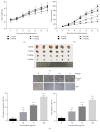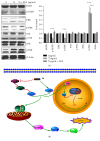Molecular Role of EGFR-MAPK Pathway in Patchouli Alcohol-Induced Apoptosis and Cell Cycle Arrest on A549 Cells In Vitro and In Vivo
- PMID: 27830146
- PMCID: PMC5086517
- DOI: 10.1155/2016/4567580
Molecular Role of EGFR-MAPK Pathway in Patchouli Alcohol-Induced Apoptosis and Cell Cycle Arrest on A549 Cells In Vitro and In Vivo
Abstract
Nowadays, chemotherapy is still the main effective treatment for cancer. Herb prescriptions containing Pogostemon cablin Benth (also known as "Guang-Huo-Xiang") have been widely used in Chinese medicine today. In our research, we found that patchouli alcohol, a compound isolated from the oil of Pogostemon cablin Benth, exerted antitumor ability against human lung cancer A549 cells ability both in vitro and in vivo. MTT assay was used to assess cell viability. Hoechst 33342 staining and TUNEL cover glass staining provided the visual evidence of apoptosis. Caspase activity measurement showed that patchouli alcohol activated caspase 9 and caspase 3 of mitochondria-mediated apoptosis. Consistently, patchouli alcohol inhibited the xenograft tumor in vivo. Further investigation of the underlying molecular mechanism showed that MAPK and EGFR pathway might contribute to the antitumor effect of patchouli alcohol. Our study proved that patchouli alcohol might be able to serve as a novel antitumor compound in the clinical treatment of lung cancer.
Figures





Similar articles
-
A pharmacokinetic study of patchouli alcohol after a single oral administration of patchouli alcohol or patchouli oil in rats.Eur J Drug Metab Pharmacokinet. 2016 Aug;41(4):441-8. doi: 10.1007/s13318-015-0272-7. Epub 2015 Mar 10. Eur J Drug Metab Pharmacokinet. 2016. PMID: 25753831
-
Patchouli alcohol, an essential oil of Pogostemon cablin, exhibits anti-tumorigenic activity in human colorectal cancer cells.Int Immunopharmacol. 2013 Jun;16(2):184-90. doi: 10.1016/j.intimp.2013.04.006. Epub 2013 Apr 17. Int Immunopharmacol. 2013. PMID: 23602914
-
Patchouli oil ameliorates 5-fluorouracil-induced intestinal mucositis in rats via protecting intestinal barrier and regulating water transport.J Ethnopharmacol. 2020 Mar 25;250:112519. doi: 10.1016/j.jep.2019.112519. Epub 2019 Dec 25. J Ethnopharmacol. 2020. PMID: 31883475
-
Therapeutic potential of Pogostemon cablin herb: a comprehensive review.Pharm Pat Anal. 2022 Nov;11(6):213-224. doi: 10.4155/ppa-2022-0021. Epub 2022 Dec 13. Pharm Pat Anal. 2022. PMID: 36511100 Review.
-
A Comprehensive Review on Pharmacological Activities of Pachypodol: A Bioactive Compound of an Aromatic Medicinal Plant Pogostemon Cablin Benth.Molecules. 2023 Apr 14;28(8):3469. doi: 10.3390/molecules28083469. Molecules. 2023. PMID: 37110702 Free PMC article. Review.
Cited by
-
Pogostemon cablin (Blanco) Benth granule revealed a positive effect on improving intestinal barrier function and fecal microbiota in mice with irinotecan-induced intestinal mucositis.Arch Microbiol. 2023 Apr 8;205(5):179. doi: 10.1007/s00203-023-03526-8. Arch Microbiol. 2023. PMID: 37029820
-
Panax Notoginseng Saponins Regulate Transforming Growth Factor-β1 through MAPK and Snail/TWIST1 Signaling Pathway to Inhibit Epithelial-Mesenchymal Transition of Pulmonary Fibrosis in A549 Cells.Evid Based Complement Alternat Med. 2022 Jul 12;2022:3744618. doi: 10.1155/2022/3744618. eCollection 2022. Evid Based Complement Alternat Med. 2022. PMID: 35865337 Free PMC article.
-
Patchouli alcohol induces G0 /G1 cell cycle arrest and apoptosis in vincristine-resistant non-small cell lung cancer through ROS-mediated DNA damage.Thorac Cancer. 2023 Jul;14(21):2007-2017. doi: 10.1111/1759-7714.14982. Epub 2023 May 30. Thorac Cancer. 2023. PMID: 37249164 Free PMC article.
-
Pogostemon cablin Triggered ROS-Induced DNA Damage to Arrest Cell Cycle Progression and Induce Apoptosis on Human Hepatocellular Carcinoma In Vitro and In Vivo.Molecules. 2020 Nov 30;25(23):5639. doi: 10.3390/molecules25235639. Molecules. 2020. PMID: 33266043 Free PMC article.
-
An In Vitro Evaluation of the Molecular Mechanisms of Action of Medical Plants from the Lamiaceae Family as Effective Sources of Active Compounds against Human Cancer Cell Lines.Cancers (Basel). 2020 Oct 13;12(10):2957. doi: 10.3390/cancers12102957. Cancers (Basel). 2020. PMID: 33066157 Free PMC article. Review.
References
MeSH terms
Substances
LinkOut - more resources
Full Text Sources
Other Literature Sources
Medical
Research Materials
Miscellaneous

